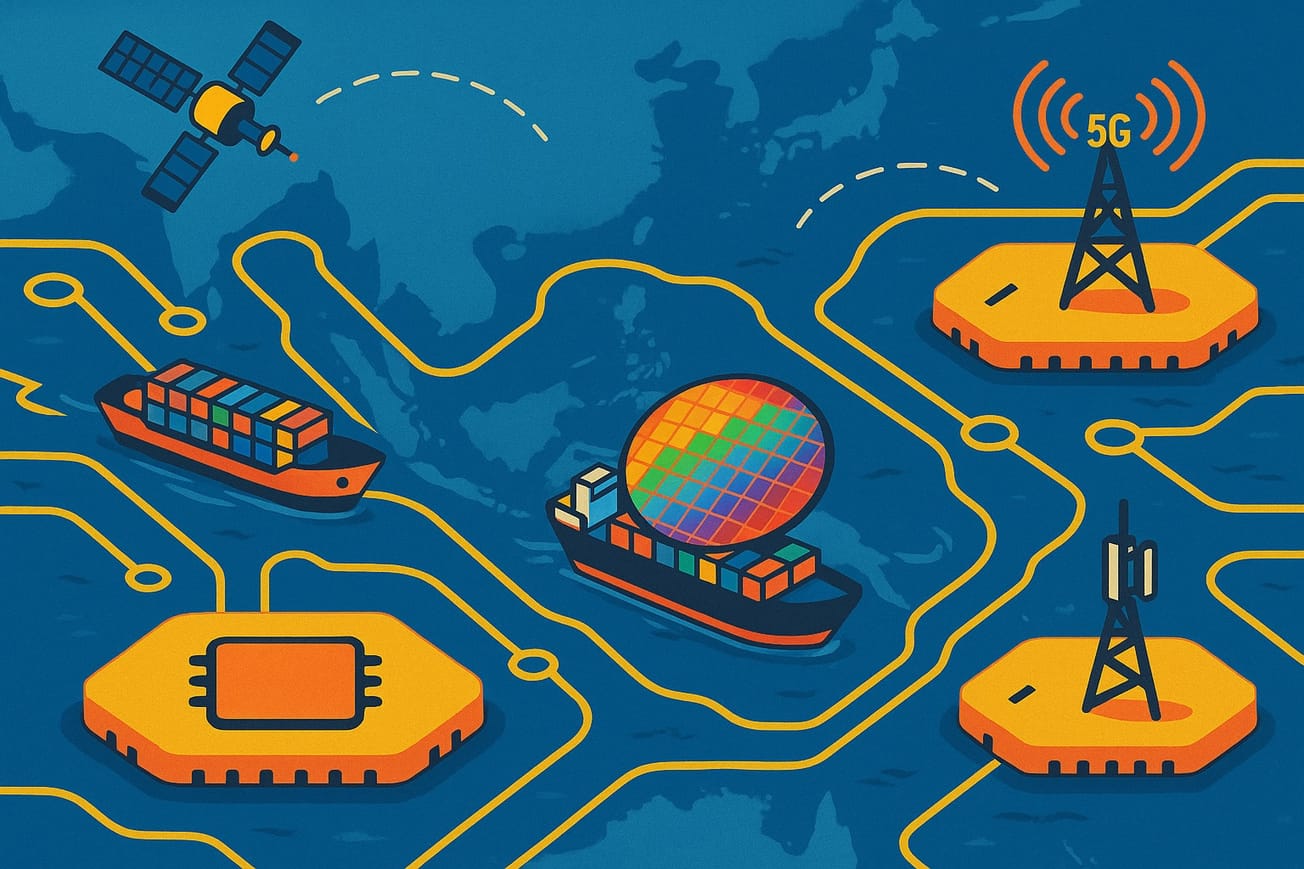

🔹As geopolitical bifurcation deepens, access to markets, technologies, and capital will hinge on alignment rather than cost or scale, with frameworks like the US-led IPEF and China-backed RCEP creating competing regulatory ecosystems.
🔹Companies must institutionalize geopolitical intelligence to embed scenario planning and risk assessment, anticipate policy shifts, sanctions, and map alignments and regulatory constraints.
🔹Accelerating regulatory splits span digital governance, export controls, data localization, and environmental standards and demand country-specific compliance, especially for technology and dual-use sectors.
🔹Infrastructure choices carry trade-offs. BRI-linked finance and market access come with elevated political risk, while Quad/G7 coalitions offer higher standards but heavier compliance; sizable PPP opportunities in Southeast Asian logistics, transport, energy, and digital infrastructure are likely.
🔹Technological competition, fragmented trade, and infrastructure diplomacy are redefining the regional business environment; success today relies on strategic foresight, regional adaptability, and employing robust risk intelligence services for strategic awareness.
The Indo-Pacific region is emerging as the epicenter of great power competition and intensifying strategic rivalry between the United States and China. This evolving landscape is transforming the regional operating environment for governments and businesses alike, creating both risks and opportunities that demand a recalibrated strategic approach.
At the heart of this transformation is the rapidly advancing technology landscape. With projected exponential growth in data center capacity and regional investment, countries like China, Japan, South Korea, and Singapore are becoming critical players in the global digital economy. However, the US-China tech rivalry is reshaping access to markets and technologies, while nations such as Japan and South Korea are hedging by enhancing bilateral cooperation and pursuing multilateral trade partnerships.
Simultaneously, the region’s trade dynamics are undergoing a structural shift. The imposition of tariffs and retaliatory trade measures by the US and China has pushed countries to diversify their economic engagements. Middle powers like Vietnam, Malaysia, and India have emerged as alternative manufacturing hubs through the “China+1” strategy, reaping benefits from redirected trade flows and FDI. Two contrasting multilateral frameworks—the China-led Regional Comprehensive Economic Partnership (RCEP) and US-led Indo-Pacific Economic Framework for Prosperity (IPEF)—underscore the bifurcated economic order. RCEP promotes open trade and deep regional integration with simplified rules of origin and digital governance mechanisms. In contrast, IPEF emphasizes resilient supply chains, clean economy goals, and fair trade standards but lacks traditional market access incentives.
Geopolitical factors now play a greater role in determining market access than cost efficiency or operational scale alone.
Infrastructure diplomacy has emerged as a key battleground. China’s Belt and Road Initiative (BRI) continues to expand its footprint across the Indo-Pacific, often accompanied by concerns over debt-trap risks and leverage. In response, the US and allies have launched alternatives like the Blue Dot Network and Quad-led infrastructure initiatives promoting transparent and sustainable development.
Businesses must navigate growing complexity, with success depending on agility and resilience amid shifting regulations. Geopolitical factors now play a greater role in determining market access than cost efficiency or operational scale alone. To stay competitive, companies need to diversify supply chains, form strategic infrastructure partnerships, and embed geopolitical insights into their planning. Compliance with evolving rules around data localization, export controls, and digital governance is becoming essential. While Southeast Asia’s infrastructure gap offers major growth opportunities, it also brings increased political and regulatory risks.
Ultimately, businesses that can balance cost-efficiency with strategic foresight, and align with emerging regional frameworks while remaining responsive to geopolitical shifts, will be best positioned to thrive in the Indo-Pacific’s dynamic and contested future.
Technology Landscape in the Indo-Pacific
The Indo-Pacific region stands at the forefront of tech innovation and leadership. Since the 1970s, the region has seen a consistent rise in innovation and production owing to China’s economic liberalization, the US’s technological leadership, and economic globalization. The digital infrastructure across the region is growing rapidly, driven by a surge in data center investments, a market projected to grow at a compound annual rate of 12.6% from 2024 to 2032, potentially reaching USD 71.7 billion by the end of that period. China leads the market with 449 data centers, and the region’s total infrastructure capacity is expected to more than double—from 10,500 to 24,800 megawatts—by 2028.
Technological infrastructure has become both a catalyst for growth and a battleground for strategic influence.
The ongoing digital transformation in the Indo-Pacific is deeply intertwined with the region’s shifting geopolitical and political-economic landscape. As nations increasingly use digital tools as part of their economic statecraft, including AI governance, cybersecurity measures, and data governance frameworks, technological infrastructure has become both a catalyst for growth and a battleground for strategic influence.
The region is positioning itself as a key player in shaping the future of global digital governance, with various countries promoting unique approaches to internet regulation, cybersecurity frameworks, and AI standards. These shifts are not only altering trade flows and investment patterns but are also reshaping strategic partnerships—establishing the Indo-Pacific as both a center of innovation and a contested space where the contours of the emerging digital world order are being defined.
US-China Technological Rivalry and Its Regional Impact
The US-China rivalry for technological supremacy has made the region a focal point for competition. This creates risks, but simultaneously offers regional economies avenues for growth, investment, and technological advancement.
Amid US efforts to reduce reliance on China and minimize exposure to strategic risks, China continues to leverage informal trade networks, including intermediaries, shell companies, gray-market suppliers, and third-party countries to access critical technologies—even involving US allies such as Japan, South Korea, and Taiwan. While the US intensifies restrictions on China’s access to advanced semiconductors and pulls back from free trade commitments, China appears to promote a more open, multilateral trade and investment agenda to strengthen regional economic ties, particularly with ASEAN, through initiatives like RCEP and the BRI. While Southeast Asian economies benefit significantly from trade with China, there is also caution about China’s capacity to use economic influence for strategic purposes. Consequently, nations in the region are more likely to adopt hedging strategies in response to growing reliance on China and escalating geopolitical tensions.
This intensifying tech rivalry has become the most influential geopolitical factor shaping the technology landscape in the Indo-Pacific. The competition has recently escalated, with China introducing its toughest restrictions on critical minerals in December 2024, following the US's decision to impose export controls on 24 types of semiconductor manufacturing equipment and blacklist 140 Chinese firms. The export controls announced by the Bureau of Industry and Security (BIS) on October 7 target advanced chips and manufacturing tools, extending the reach of US regulations to foreign supply chains. This move has had a significant impact on tech companies across the Indo-Pacific region.
Against this backdrop, Japan and South Korea agreed in May 2025 to deepen technological collaboration in critical technologies and industries and expressed support for South Korea’s bid to join the Comprehensive and Progressive Agreement for Trans-Pacific Partnership (CPTPP). In this light, they also expressed mutual concerns about the US’s increasing protectionist policies and intensifying US-China rivalry, underscoring the need to enhance their economic ties.
Economic Integration and Multilateral Frameworks
Despite geopolitical uncertainties, intra-regional investment in high-tech industries is on the rise. Singapore’s Ada Infrastructure is committing USD 9.7 billion to develop data centers in Japan, and Taiwan’s Vanguard International Semiconductor (VIS) is investing USD 7.8 billion in Singapore to boost semiconductor production. Moreover, India emerged as the top FDI destination in 2024, attracting USD 76 billion, driven by semiconductor and renewable energy projects.
In the context of wider geo-economic dynamics, the IPEF seeks to deepen economic engagement with 12 other countries with a strong emphasis on facilitating digital trade. One of its key goals is to promote the seamless flow of data across borders, providing mutual economic benefits for the US and its regional allies while serving as a strategic counterbalance to China. Conversely, RCEP offers a different framework, with China promoting an open and multilateral approach for regional trade and investment, especially in collaboration with ASEAN countries. RCEP encompasses measures that establish standards and guidelines for certification procedures, the legal recognition of electronic signatures, the protection of consumers engaging in online transactions, and the safeguarding of individuals’ personal data to ensure privacy and security.
Moreover, the geopolitical dynamics in the region also created an imperative for the Quadrilateral Security Dialogue ("Quad") to increasingly participate in technology cooperation, leading to initiatives like the Quad Investors Network (QUIN), which has supported major strategic investments in emerging technologies.
The growing role of multilateral initiatives such as the Quad and IPEF highlights the increasing importance of aligning business strategies with evolving geopolitical alliances and technology cooperation efforts.
The US-China rivalry is reshaping supply chains, investment flows, and policy and regulatory frameworks, which can disrupt tech firms’ operations and increase the compliance burden. This does not diminish the fact that technology firms are also likely to see significant growth opportunities, which can be leveraged through strategic partnerships with local governments or companies, particularly in areas such as data infrastructure development and advanced chip manufacturing.
Further, firms should diversify supply chains and collaborate with multiple regional hubs, especially ASEAN economies, Japan, South Korea, and India. Engagement should focus on criteria such as market access, standards alignment, logistics capacity, and policy stability. Additionally, the growing role of multilateral initiatives such as the Quad and IPEF highlights the increasing importance of aligning business strategies with evolving geopolitical alliances and technology cooperation efforts.
To successfully navigate this landscape, firms will require careful assessment of geopolitical risks as well as comprehensive risk mitigation strategies that address supply chain bifurcation, regulatory compliance challenges, and concerns around technological sovereignty. Balancing these risks and opportunities, companies can position themselves to thrive in the highly competitive and geopolitically charged Indo-Pacific region.
Trade Dynamics amid Geopolitical Competition
The proliferation of multilateralism has led to a more fragmented but also diversified set of partnerships, creating new opportunities and challenges for regional economies. Moreover, supply chains are undergoing significant reconfiguration as companies seek to mitigate geopolitical risks by diversifying production locations, and adopting strategies like “China+1” to enhance resilience. This reconfiguration is not only a response to rising trade tensions but also a reflection of broader shifts in global manufacturing and consumer demand. Parallel to these shifts, modern means of economic statecraft are influencing trade patterns and investment decisions across the Indo-Pacific. Together, these factors are fundamentally reshaping the region’s trade landscape, forcing governments and businesses alike to navigate a more complex, multipolar economic environment where geopolitical considerations are increasingly intertwined with significant economic impacts.
US-China Trade Tensions
The US-China trade tensions have had a profound ripple effect across the region, triggering what the Japanese economist Kaname Akamatsu describes as a “flying geese pattern” of economic growth. The imposition of universal tariffs by the US, including a 10% levy on all imports and additional duties of up to 50% for trade-surplus countries has accelerated a shift in trade dynamics, pushing Indo-Pacific economies to recalibrate their policies. Conversely and equally assertive was China’s response, introducing retaliatory tariffs of up to 125% on certain US products and filing complaints with the WTO. Although a temporary agreement in May 2025 led to a reduction in US tariffs on Chinese imports from 145% to 30% and China’s tariffs from 125% to 10%, the long-term message was clear, prompting a lasting shift in the region toward economic diversification.
Shifting Trade Patterns and Emerging Regional Winners
Ironically, the trade tensions brought unexpected benefits to several middle powers in the region. During Trump’s first presidency, South Asian economies experienced notable economic growth as they increasingly positioned themselves as viable alternatives to China in global supply chains. While traditional trade flows were disrupted due to the tariffs, these countries sought to fill the gap by expanding their manufacturing capacity and export markets, consequently not just boosting their trade volumes but also enhancing their strategic importance in the global economy. Moreover, a 2019 report published by Nomura, a Japanese financial holding company, analyzed which countries have gained the most from the ongoing US-China trade war. Among Indo-Pacific economies deemed beneficiaries, Vietnam stood out as a clear winner, with a 7.9% GDP boost attributed to trade diversion, primarily from increased US imports shifting away from China. Malaysia also saw significant gains, though primarily from a rise in Chinese imports as Beijing looked for alternatives to US goods. Other Indo-Pacific economies, namely South Korea, Singapore, and Hong Kong, were also among the broader group benefiting from shifts in trade patterns.
Within the region, ASEAN is a key beneficiary of this shifting trade dynamic. In Q1 2024, ASEAN became China’s largest trading partner, with bilateral trade reaching USD 300 billion, marking an 8.5% increase compared to the previous year. This development highlights ASEAN’s growing role as a strategic manufacturing hub and a diplomatic bridge between global powers. The bloc now makes up 15.85% of China’s total foreign trade, all while expanding its engagement with other major economies.
The conclusion of the ASEAN-China Free Trade Area 3.0 negotiations in May 2025, a process that began in 2022, highlights China’s efforts to position itself as a stable and dependable economic partner. This move contrasts with perceived US unpredictability and reinforces China’s strategy to deepen regional economic integration and strengthen ties with ASEAN. At the same time, ASEAN is on track to become the world’s fourth-largest economy by 2030, reflecting its rising global influence. Regional leaders have adopted the ASEAN Community Vision 2045, aiming to position the bloc as the center of economic growth in the Indo-Pacific, reinforcing its role as a key driver of regional development and integration.
Multilateral Trade Frameworks: RCEP vs IPEF
RCEP, which came into effect in early 2022, is the world’s largest free trade agreement, uniting 15 economies that collectively contribute over 30% of global GDP. Alongside tariff reduction and eliminating duties on more than 90% of goods traded among members, it simplifies rules of origin, requiring just 40% of a product’s content to be sourced from member countries to qualify for duty-free treatment. This has promoted deeper regional integration, enabling more flexible and efficient supply chains across Indo-Pacific economies. The agreement’s effects are notable as intra-RCEP trade is projected to grow by nearly 2%, or about USD 42 billion, due to trade creation. However, this also results in USD 25 billion in trade diversion from non-members, signaling RCEP’s increasing economic influence within the Indo-Pacific region.
Beyond the economic value, the RCEP framework carries significant geopolitical weight, underscoring Asia’s growing role in trade governance and reinforcing economic interdependence among states at a time when global trade faces fragmentation. More importantly, China’s central role in RCEP signifies its leadership in regional trade, allowing it to expand its influence in the region. Looking ahead, RCEP’s success hinges on the member states’ ability to align their interests and efforts per the framework, which could lead to greater regional economic integration.
On the other hand, IPEF, launched in May 2022, brings together 14 member nations that collectively account for about 40% of global GDP, offering a distinct model of regional economic cooperation. Moving away from the traditional trade agreement model centered on tariff reductions, IPEF is structured around four key pillars. The Trade Pillar aims to foster innovative trade and technology policies that drive economic growth and attract investment. The Supply Chain Agreement is designed to enhance regional supply chain resilience, including the creation of a crisis response mechanism. The Clean Economy Agreement promotes regional climate action by encouraging green investment. The Fair Economy Agreement focuses on improving the business environment by tackling corruption, strengthening the rule of law, and increasing transparency in tax systems. Overseeing these efforts is a ministerial-level IPEF Council, established to coordinate and guide the framework’s implementation and activities.
IPEF’s overall impact has been limited by the US’s unwillingness to provide conventional market access, a key incentive in most trade deals. Progress on the Trade Pillar has come to a halt after Washington shifted its stance on digital trade rules, opting to preserve flexibility in domestic policymaking rather than commit to binding international standards. In response, regional analysts have urged middle powers such as Japan, South Korea, Singapore, and Australia to start exploring stronger economic collaboration without relying on US involvement, to maintain momentum toward regional integration.
In contrast to RCEP, IPEF marks a shift by the US toward shaping rules rather than expanding market access. Aiming to influence trade, labor, and climate standards across the Indo-Pacific, its non-binding nature and lack of tariff concessions may limit its appeal to emerging economies seeking concrete economic gains. Nonetheless, IPEF holds potential as a foundation for deeper regional cooperation. If it can demonstrate tangible benefits, particularly in supply chain security and climate resilience, it may evolve into a more formal framework with expanded commitments.
Diversification and Resilience
The US has adopted a friendshoring approach, aiming to relocate supply chains to trusted partners in the Indo-Pacific through initiatives such as the Minerals Security Partnership and the Chip 4 Alliance. However, these efforts have also encountered obstacles, as regional partners have voiced discontent over limited tangible gains and concerns about US policies prioritizing domestic subsidies, which could potentially undermine mutual benefits.
The shifting approach is particularly evident in the semiconductor sector, where geopolitical tension has prompted firms to shift toward “China+1” and “Taiwan+1” strategies for production. This has resulted in a reconfiguration of global foundry and assembly operations. Leading companies such as TSMC, Samsung, and Intel are investing in advanced manufacturing facilities in the US, while Chinese semiconductor firms are accelerating the development of mature technologies to meet growing domestic demand.
As companies seek to reduce reliance on single-source suppliers, Southeast Asia is rising as a key manufacturing hub, with noticeable shifts in production patterns across the region. Indonesia and Vietnam are at the forefront of this shift, evidenced by their strong FDI and export performance. In 2023, Indonesia attracted approximately USD 33 billion in greenfield manufacturing FDI, while Vietnam secured USD 16 billion. Their export volumes reached around USD 290 billion and USD 440 billion, respectively. While China remains a dominant force in global manufacturing, it actively contributes to these changing dynamics in the region as Chinese manufacturers increasingly relocate operations to Southeast Asian countries seeking to capitalize on lower costs and proximity to emerging markets.
In this light, several Southeast Asian countries are now investing in expanding their manufacturing base and modernizing infrastructure, namely in transport and logistics, to meet growing export demands. As trade in the region rises, logistics providers and private investors may find significant growth opportunities. According to McKinsey, there is a USD 60 billion gap between current or planned infrastructure spending and the investment needed to support future trade flows, highlighting the need for greater private sector involvement.
However, it is important to note that the region is far from uniform. FDI, trade patterns, industry development, and access to resources vary widely across countries. As both regional and multinational companies broaden their manufacturing base, the impact and extent of the trade shifts differ across geography and sectors. Hence, the China+1 diversification is bound to evolve in complex ways as companies focus on a rapidly growing customer base, operational agility, and geopolitical risks.
The Strategic Position of Middle Powers
Amid shifting trade patterns, middle powers can offer new market opportunities and alternative manufacturing hubs. Needless to say, companies operating in the region will require comprehensive diligence and deep vetting of these newly growing regional players. However, middle powers in the Indo-Pacific today can offer more than traditional cost advantages: they are increasingly a strategic gateway to broader Indo-Pacific markets. This regional diversification is essential to mitigate risks associated with overreliance on any single country or supply route amid persistent geopolitical uncertainty.
Here, multilateral trade frameworks present both challenges and opportunities. RCEP’s deep integration and tariff benefits strengthen China’s regional influence and enhance supply chain efficiency within its member states, while the US-led IPEF focuses on setting regulatory and sustainability standards, albeit with less emphasis on market access. Companies must navigate these competing frameworks by aligning their trade, compliance, and investment strategies to leverage advantages from both RCEP and IPEF while anticipating potential fragmentation or overlap in rules and standards.
Middle powers in the Indo-Pacific today can offer more than traditional cost advantages: they are increasingly a strategic gateway to broader Indo-Pacific markets.
Additionally, infrastructure gaps in transport and logistics highlight significant opportunities for private sector investment, which can support rising trade volumes and modernizing manufacturing bases across the region. However, uneven development and resource access mean that companies must tailor their strategies to specific country contexts and sectoral dynamics.
Infrastructure Outlook
The past decade has showcased that within the wider context of great power competition, infrastructure diplomacy has emerged as a tool of soft power, and the Indo-Pacific as the main stage for this rivalry. The region as a conceptual and geopolitical construct reflects historical context as well as political strategy, and given the region’s growing strategic significance, infrastructure has emerged as a central arena of competition.
At the heart of China’s strategy in the region is the BRI, through which China seeks to expand its influence by funding and constructing major infrastructure projects, such as ports, highways, and rail networks. This network of economic linkages significantly extends China’s reach across the region, sparking concerns about debt dependency and sovereignty, with critics warning of China’s debt-trap diplomacy. In this light, Sri Lanka’s case, where it was forced to lease the Hambantota Port to China upon failure to repay loans, is often cited as a cautionary example of China’s leverage and the risks involved.
Competition between these blocs not only shapes trade and investment flows but also influences the balance of power, with infrastructure development serving as a key battleground for control over the Indo-Pacific’s future economic order.
In response, the US and its allies launched alternative efforts to counter China’s economic influence. These include the Blue Dot Network initiated by the US, Japan, and Australia to promote high-standard, transparent infrastructure financing as a counterweight to the BRI. Meanwhile, the Quad alliance has prioritized initiatives such as resilient supply chains, digital infrastructure, and responsible investment practices, aiming to offer a more sustainable and transparent development model for the region.
This bifurcation reflects broader geopolitical rivalrous blocs, marking infrastructure as a tool for economic statecraft and an indicator of alignment with respective blocs. The competition between these blocs not only shapes trade and investment flows but also influences the balance of power, with infrastructure development serving as a key battleground for control over the Indo-Pacific’s future economic order.
For businesses, understanding this landscape is essential, as infrastructure investments now also carry geopolitical significance. While China’s BRI promises infrastructure growth, creating opportunities in construction, logistics, and related sectors, these come with risks such as political influence, debt concerns, and governance shifts, exemplified by the case of Sri Lanka’s Hambantota Port lease to China. Conversely, US and western-led initiatives that focus on transparency and sustainability offer a more stable and predictable investment environment.
This evolving bifurcation in infrastructure diplomacy means that firms will increasingly need to navigate complex political alliances and competing development models. Strategic due diligence, risk management, and adaptive partnership strategies will be vital for companies looking to operate effectively across different parts of the Indo-Pacific. Moreover, with infrastructure serving as a foundational element of regional economic growth and integration, businesses in sectors like supply chain management, digital infrastructure, and sustainable development should closely monitor geopolitical trends shaping infrastructure financing. Doing so will help them identify emerging markets, anticipate regulatory changes, and capitalize on growth opportunities tied to the region’s shifting economic environment.
Business Implications: Outsized Risk, Outsized Opportunity
The region’s evolving landscape, defined by technological competition, fragmented trade, and infrastructure diplomacy, is reshaping the environment for global and regional businesses. Companies in the region now operate in an environment where great power competition, regulatory divergence, and shifting trade patterns increasingly influence economic outcomes.
Companies must recalibrate their strategies in response to the bifurcation, where access to markets, technologies, and capital will be increasingly influenced by geopolitical alignment instead of being determined by cost competitiveness or operational scale. The reconfiguration of global supply chains has created avenues for diversification, with certain countries emerging as alternative production hubs, attracting strong FDI flows, and ramping up manufacturing. However, significant variations exist across the region, and companies must therefore develop location-specific strategies, balancing cost-effectiveness with risk mitigation and operational agility.
Businesses now must contend with a divergent regulatory environment, particularly in the realms of digital governance, export controls, data localization, and environmental standards. Tech companies in particular are likely to face complexities in navigating export controls, data laws, investments, and security standards. As countries like India and Vietnam create robust rules on data governance and digital sovereignty, companies must remain agile and responsive to the evolving regulatory landscape. Divergent legal compliance should be a core component of corporate strategy, particularly for firms handling sensitive technologies or operating in dual-use sectors.
Each infrastructure approach has clear trade-offs. While BRI-linked projects may bring advantages such as capital and market access, they are also likely to carry political risks, as evident with the Hambantota Port lease case. Conversely, Quad- or G7-aligned coalitions adhere to stricter governance and standards, which may incur longer lead times, complex compliance, transparency protocols, and rigorous due diligence. Private sector participation is increasingly essential, particularly in Southeast Asia’s infrastructure investment gap, which presents significant opportunities in logistics, transport, energy, and digital infrastructure through Public-Private Partnerships (PPPs).
Most importantly, to navigate the pointers explained above, companies operating in the region must invest in robust geopolitical intelligence capabilities. This involves integrating geopolitical risk assessments into their commercial strategies and scenario planning processes. By doing so, businesses can better anticipate and prepare for policy shifts, sanctions, and regulatory fragmentation. These assessments can also factor in geopolitical alignments, regulatory chokepoints, and long-term regional stability. Investing in these capabilities will enable companies to develop more flexible business models, build a deeper understanding of regional dynamics, and ultimately mitigate risks effectively by building trust locally.
To this end, companies should consider forming partnerships with specialized intelligence advisories that can offer real-time insights, regional expertise, and analysis tailored to specific sectors and geographies. In the near future, the need to contend with complex and evolving risk in the Indo-Pacific will require standing up a dedicated in-house geopolitical intelligence department, which can help integrate hyper-relevant and timely analysis into core decision-making and long-term objectives. The risks that characterize the region today are substantial, complex, and growing rapidly, but so too are the opportunities and tools to actualize significant upside.








